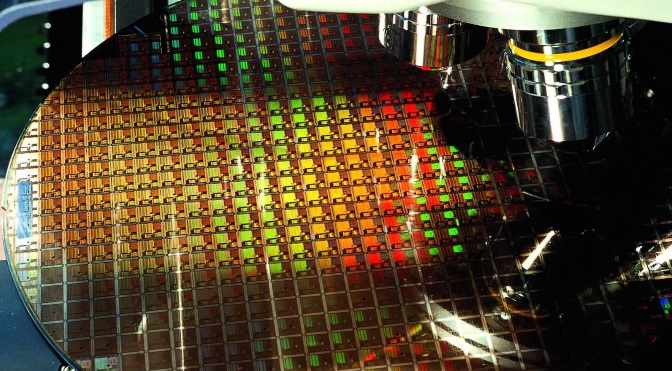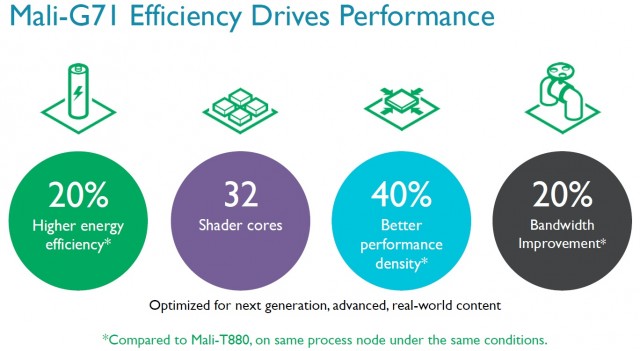
ARM announces new Cortex-A73 CPU, Mali G71 GPU
By Joel Hruska on May 31, 2016 at 7:30 am Comment
ARM-Cortex A72
ARM has announced a pair of new products at Computex this year, with early production later this year and mainstream launches in 2017. The new Cortex-A73 and Mali-G71 are both significant updates to previous products, but the Mali-G71 is arguably the larger departure from the company’s previous hardware.
The Mali-G71 is based on ARM’s Bifrost GPU architecture (the company’s previous products were built on the Midgard GPU architecture). Bifrost is designed to be the most scalable Mali design ARM has built to date, as well as implementing full coherency. Some Mali GPUs supported L2 cache coherency already, but ARM appears to be implementing the feature across a wider range of products. Vulkan and AR/VR are both supported as well.
BiFrost

According to ARM, the G71 architecture offers 20% higher energy efficiency, 32 shader cores, 40% better performance density, and 20% bandwidth improvements all compared to a Mali-T880 on the same process node and under identical conditions. The Mali-T880 is a 16-core GPU, which implies that ARM’s gains should be quite significant once you consider that the next-gen chip will also be built on both 14nm and 10nm.

Mali-Perf
ARM is even predicting that a 16-core version of the Mali G71 in late 2016 / early 2017 will be able to beat a 2015 discrete laptop GPU, and while we don’t know which GPU they’re comparing against, that’s still a significant achievement for a company whose GPU division has mostly been known for powering low-end set-top boxes, smart TVs, and budget products. Maximum performance uplift is 50% above Midgard, which implies ARM will use more shader cores but clock them somewhat lower to compensate (this approach can pay significant dividends, since power consumption tends to grow more slowly when you add shader cores as opposed to clocking fewer cores at higher clocks.)
ARM also claims that Mali-G71 will deliver up to 120Hz refresh rates, 4K screen support, a 4ms graphics pipeline (critical for VR), and support for up to 4x MSAA. Like Qualcomm, ARM wants its own GPU to compete with mobile VR experiences, even though that field is relatively new and limited at this point.
The Cortex-A73
Last year, ARM unveiled the Cortex-A72, the more efficient and higher performing follow-up to its first high-end 64-bit processor, the Cortex-A57. This year, they’re launching the Cortex-A73, which offers a smaller overall improvement in performance but should be significantly more power efficient.
ARM-Comparison

This chart is relative to the Cortex-A7 in all respects. The Cortex-A57 was roughly 3.4x faster than the A7, while the Cortex-A72 was ~4.9x faster — a gain of 44%. The Cortex-A73 looks to be about 5.5x faster than the A7, which makes it just 12% faster than the CPU it replaces at the top of ARM’s product stack. The Cortex-A73 uses 80% as much power as the A72 when built on the same process and only 57% as much energy when process node enhancements are factored into the equation. If ARM’s figures are correct, the Cortex-A73 actually consumes less power than the low-power, efficient Cortex-A7.
Presumably we will still see some big.Little configurations with these APUs, since the newer Cortex-A53 has largely replaced the 32-bit A7 as the “little” CPU core of choice, and its performance is significantly higher than its 32-bit counterpart.
One of ARM’s goals for the A73 is to allow the chip to run at higher frequencies for longer periods of time. When the first 20nm SoCs became available, it was clear that while the Cortex-A57 could hit high clock rates, it often couldn’t sustain them due to thermal load.

Cortex-A73
The A73 is expected to increase clock only modestly over the A72, but it should be able to hold its base clock quite effectively, provided OEMs build designs with the necessary cooling.
A chip that can only hold top clock for five seconds at a time will sag in any task that takes longer than five seconds, especially if forced to drop to 60-70% of base clock to maintain appropriate temperatures. A CPU that can hold its top clock for 10 seconds and then drops just 10% will feel much faster than their respective clock speeds would otherwise indicate.
In absolute terms, it looks like the Bifrost GPU architecture packs more of a punch than the Cortex-A73, but put the two together and we should see further evolution of ARM’s performance in 2017.